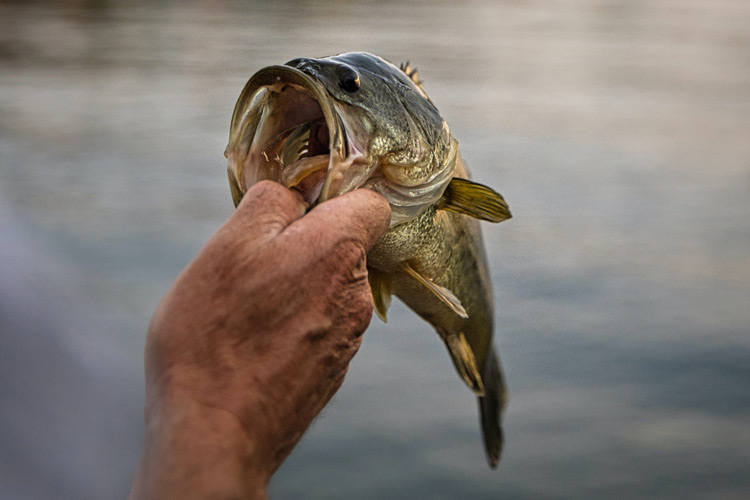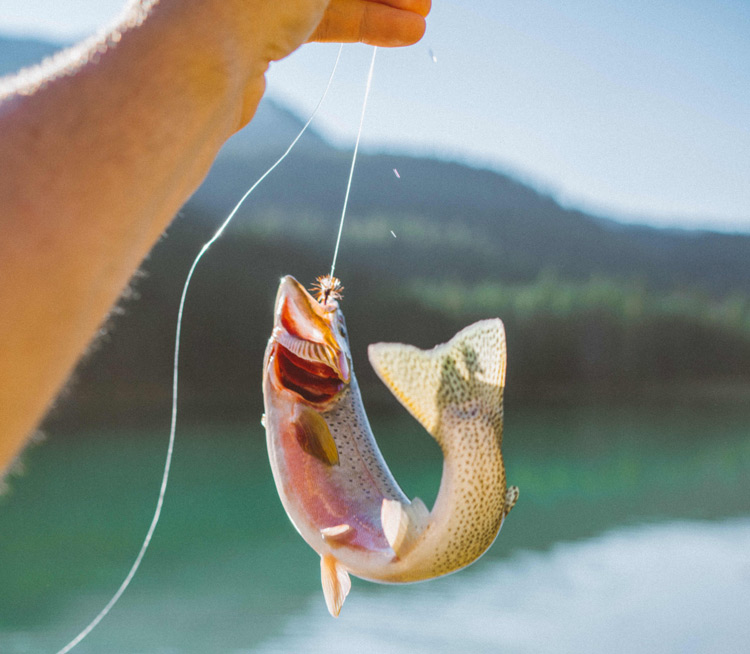Florida – the sunshine state – is mostly surrounded by vast amounts of water. So, it is no surprise that fishing is such a popular affair throughout the state. From Orlando to Tampa to Miami and the Florida Keys, an array of fish species can be found. Here are the top 10 to catch:
Tarpon (Megalops)

First on this list is the Tarpon – also nicknamed the silver king from the flash that reflects off its body when jumping out of the water. This prehistoric fish is one of the most fun fish to catch in the ocean. They love warmer waters like those found off the coast of Florida along the Gulf of Mexico.
Tarpon are rather large, thick fish that are usually silver with a green to dark green back. Their scales are large and thick; thus, causing the silver flash when jumping. These fish are also toothless and primarily eat sardines, shrimp, pinfish, catfish, and even small dead fish along the bottom of the sea floor. As one of the only fish that has a swim bladder. This allows them to breathe air while they are out of the water.
The silver king females are typically able to live over 50 years while the males are smaller and live about 30 years. Females can grow up to eight feet long and 300 pounds. They are definitely a fight once caught. Tarpon spawn April through July.
Redfish (Sciaenops Ocellatus)
As members of the drum family, the Florida Redfish (Red Drum) is a rather popular catch in the Sunshine State. These fish are usually a copper/bronze color with a large black spot on their caudal fin and have large scales. During their early years, Redfish feed on crustaceans and typically stay closer to the shore. They are bottom-feeders that can typically be found along shorelines, sandbars, and between deep water and shallow flats.
Anglers can catch these fish with a variety of gear – spinning rods, jigs, spoons, etc. The real challenge of fishing for Redfish is after the catch – fights can last up to an hour. Red Drums can be found mainly around the coasts of Florida year-round.
Largemouth Bass (Micropterus Salmoides)

Florida’s freshwater fish, the Largemouth Bass, is another top catch in the Sunshine State. As a member of the sunfish family, they have a distinctive appearance due to their bottom jaw protruding outward beyond the edge of their eye. Their dorsal fins are also separated by a deep divot that cannot be mistaken.
Largemouth bass are perhaps one of the most popular game fish in North America. They spawn in the spring and can be found in lakes and rivers – usually near vegetation. When exposed to the warmer climate in Florida, these fish tend to grow a bit larger than other parts of North America – averaging 18” to 24” or more. Even though they grow larger in this habitat, it still takes some time to become trophy size.
Sailfish (Istiophorus Platypterus)
Easily confused with a Swordfish, the Sailfish of Florida is another top catch of the state. These fish are typically dark blue with brownish-blue sides that fade to a silver-white belly. The biggest difference is the large dorsal fin – the sail – and it is also typically blue with black spots. Sailfish have an upper jaw that extends into a spear shape. These fish can grow up to 11 feet long or 220 pounds.
The Sailfish is Florida’s state saltwater fish. They most commonly reside in offshore waters; but, spawn in shallow water inshore during the summer. These fish are considered the fastest in the sea. While they can be found outside Florida – really anywhere there is warm water – they are a top catch for the sunshine state because Sailfish migrate to the area during the colder months.
Grouper (Epinephelinae)

Grouper are monoandric protogynous hermaphrodites which means they mature only as females while a few of the species are able to change their sex after maturity. Grouper is one of Florida’s most iconic fish to catch.
Mackerel (Scomber Scombrus)
There are three types of Mackerel species in Florida: the King Mackerel, Spanish Mackerel, and the Cero Mackerel. All three of these species can be found in the water year round; however, the Creo Mackerel are found in the Florida Keys. The largest of the three is the King Mackerel – a.k.a. Kingfish. These fish can be found in shallow waters, particularly around piers and schools of baitfish.
Spanish Mackerels reach no larger than seven to eight pounds and the females are larger than the males. These can also be found in shallow waters near piers. They are a popular catch amongst anglers in Florida due to their tastiness. The Creo Mackerel is somewhere between the King and Spanish Mackerel in size; but, only found in the southern part of the state. Anglers consider these to be the more beautiful looking of the three.
All three species have an armament of teeth and are known to be quick swimmers. Mackerel are also known for having excellent eyesight – which can help them evade being caught.
Snapper (Lutjanus)

There are hundreds of Snapper species all over the world – some of which can be found in Florida. Perhaps the most common is the red snapper. A red snapper can grow anywhere from three to 50 pounds. Snappers inhabit estuaries up to 450 meters deep. They are considered bottom-feeders. All species of snapper prefer warmer climates which is part of why Florida is such a popular spot for them. Some of the varying types include Mangrove Snapper, Yellowtail Snapper, Mutton Snapper, and Cubera Snapper.
Speckled Trout (Cynoscion Nebulosus)

From the same family as Redfish – even though they look nothing alike – Speckled Trout is another top catch for the Sunshine State. These fish are long, silver with a greenish tint that fades into white on their belly. From its broom-shaped tail to its vampire-like fangs that protrude its mouth, the Speckled Trout has a distinctive look. Speckled Trout are one of the fish with the softest flesh so it is imperative to be careful when dealing with them. It takes about two to three years for these fish to grow to full size – the females are longer than the males. On average, Speckled Trout are anywhere from 14” to 39” and one to four pounds (occassionally an eight pound trout can be found). Large Speckled Trout are known as Gator Trout by Floridaians.
Similar to other top catches in Florida, Speckled Trout enjoy saltwater where there is immense amounts of greenery. They spawn inshore from March to November and then move to deeper waters until Spring. They love warmer temperature water. Anglers love going after Speckled Trout because they are not only fun to catch; but also, delicious to eat.
Snook (Centropomus Undecimalis)

Similar to a Largemouth Bass in regards to their appearance, the Snook fish has a protruding lower jaw; and, is a greenish color that fades to a white silver belly with a long black line that goes from its head to its tail. Its dorsal fin is also split in two, both coming to a high point. Their gill covers are razor sharp. Snook can reach up to about 48” and 50 pounds.
Snooks start their lives as males but between 18” and 22”, some will transition into females. They inhabit inshore waters along shorelines and grassy areas – like most top catches. Snook cannot handle being in water below 60 degrees so they tend to stay in warmer spots; however, they can tolerate freshwater as well as saltwater. While most fish swim with the current of the water, Snook tend to swim against it to catch their prey.
Panfish (Centrarchidae)
Getting their name from their ability to always fit perfectly in a frying pan, panfish are a very popular catch in Florida. This name is technically angler slang, so they are not one particular fish species – instead, it refers to most any (but not all) fish that will never exceed the size of a pan. Some of these species found in Florida include: Bluegill, Sunfish, and Crappie.
Panfish typically inhabit lakes, ponds, and rivers. Bluegill is the most popular panfish in Florida. While fishing for these fish, one must pay the utmost attention because they are so small that sometimes, they will snag the bait and swim off before you even know.
While Bluegill are perhaps the most popular, it is said that Crappie are the biggest of the species. All Panfish are excellent for eating however. The best techniques for catching these fish are slow rolling, dabbling, and vertical jigging. These fish spawn throughout the summer and are typically congregated in large quantities – 30 to 40 panish. Do not let the mass amounts fool you, these fish can still be quite the challenge to catch.
Whether you’re a new angler or experienced, Florida has a catch for everyone. There are hundreds of fish species in and around the Sunshine State. Anglers of all ages are sure to enjoy their time out on the water. Florida is home to an abundance of trophy fish species and many of which have yet to be caught.
Looking for your next spot to fish? Use this interactive map to find the best spot to cast your hook.












Comments
Please log into your account to post comments